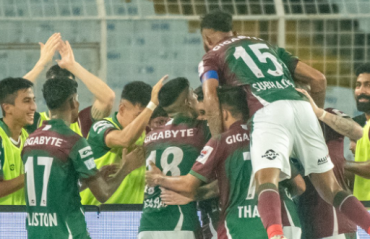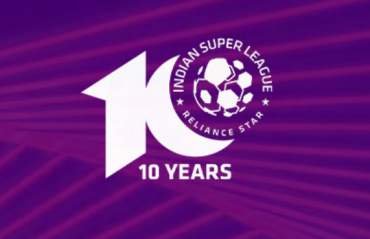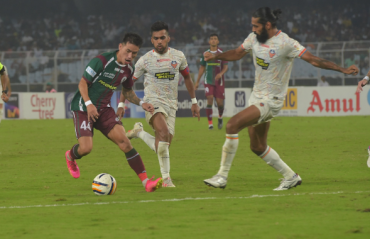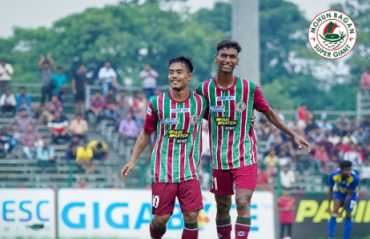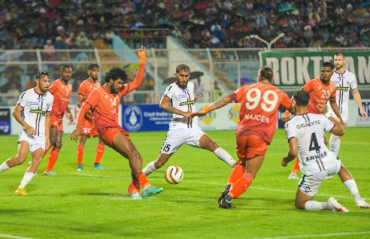SUNBURNT TERRACE: The Mohun Bagan - ATK merger has left the fans at a crossroads of doubt
- By Chiranjit Ojha

- January 18, 2020

WHAT DOES A CLUB MEAN to you when you have barely learned to speak?
When one of the first toys you are introduced to is an inflated sphere, and told that you are meant to support one particular team, your infant brain hardly manages to differentiate between the sport and the club.
Time goes by and you go about your day learning new words, reading peoples' faces, trying to climb trees and kicking around a football. You hear people talk about matches that happen in a faraway mythical place called Kolkata. About a big stadium that holds more people than your entire village. About cups made of silver and shields twice the size of yourself.
There's no TV in the house and no electricity in the area. You have never seen this team play other than pictures on the newspaper, and badly recorded footage during the evening news that you sometimes catch in your neighbour's house, when a rickety generator gives three hours of light to the area every evening. To your brain that grapples with the absurdity of weird symbols etched on a classroom blackboard, the world is a mystery, but there's an undying conviction about one thing - there's a club out there, you know it by its emblem and colours, and you know you belong to it.
Slowly, you learn that there are others. You realise that your friend loves a different club, with a different emblem and colours. You learn there's a national team, too, which everyone supports. You negotiate the complex relationship between rival clubs at the same time you learn about conflicts between nations and religions.
You are told about how you are different from the people who support the "other club." How they came from elsewhere. When you ask where they came from, you hear your first stories about the horrors of Partition, about millions losing their homes and lands and walking hundreds of miles just to reach safety. You struggle with the enormity of it all; of national divide and religious animosity rolled into one giant tragedy. You find out who among your friends and neighbours are these "other people" who came over from a different land. After careful study, you find that they're the same as you other than supporting a different club. So that's how you, at the age of four, come to understand the largest social division in the region - it's about supporting different football clubs. Same with the difference in religions; there's a third club that most Muslims support.
At some point, your father tells you you've grown big enough to go to a match. You are thrilled; going to Kolkata and watching your club in person was going to be the single biggest adventure of your life so far. You barely sleep in the days leading up to that weekend. On Saturday at dawn, you begin the arduous journey. On Sunday, you stand in a queue for six hours to be one of the early people in the stadium.
It all hits you at once. The massive buildings of the city, the traffic, the noise make you feel completely lost in a sea of people. But you find your place of belonging when you see buses and trucks full of people wearing green and maroon, waving flags that bear the emblem of your club, all going where you are going. You don't know these people, but you know they support the same club as you do, and that's enough. You become one and the same.
The sea of people you encounter in the stadium is unlike any you've seen before, or since. The noise is louder than any other place. You struggle to recognize players from a distance, squint your eyes to spot light touches and sly tackles. You are enamoured with the game, the pace, but even more so with this extended family of thousands that you have suddenly discovered. You love the chants, the hours long collective shouting match with another army of thousands, just as vocal and passionate, differentiated only by the colours of their flags.
Years later, you struggle to remember who won that first Kolkata Derby you attended. Perhaps it was a draw. It didn't matter. That day, in a giant sweaty bowl of overloaded humanity, the world had truly opened up to you for the first time.
You grow up loving the club, but eventually you come to see its myriads of flaws. Corruption in the management. Mistreatment of players. Violence among fans. You learn about the deaths in 1980. You receive your first blows from strangers dressed in different colours. At some point, the violence becomes the reason your father stops going to the games, and you are left to listen to matches on the radio, with eyes closed, visualising the action through the fluent verbal commentary.
You learn India are not very good at football. You develop a shame for not playing in the World Cup. You see other countries playing the sport with elegance that's missing from domestic football. But the love for the club stays the same, because you know the sport through the club, and the club is yours - it was here before you were born and it will be here after you die. You know one day you will return to it, and the club will be right there, with its colours and emblem, waiting to embrace you.
It takes a decade and a half but eventually you go back to it. You see the good times and the bad. You're there when on a rainy night in Bengaluru the club wins the league, crying along with strangers, chasing the team bus on foot late at night. You witness the club win the cup, too. You see it carving its path with limited resources in an evolved Indian football landscape. And slowly, with every victory, every loss, every trophy, heartbreak, every friendship made in the stands to every scuffle with a rival fan, you build the club inside you.
And then one day something happens that makes you stop in your tracks and ask a question you never thought you'd ask - is this still my club?
The above, while a subjective portrayal of my own experience as a Mohun Bagan fan, resembles that of other fans of the club; perhaps even fans of other clubs.
Everyone, who has calls himself or herself a fan of a club, and watches the club's matches whether at the stadium or on TV, is bonded with other fans of that club by bearing witness to those same events, whether good or bad. Over time, the positive and negative memories build up and that club becomes a bookmark in the fan's life that can be revisited time and again. It can be an obsession, a relief, a social occasion, a sporting pursuation. But if you stay in it long enough, the club comes to acquire a meaning to you that's yours alone; even though you love the club more or less the same way others do.
Which is why, the crossroads that Mohun Bagan fans find themselves in, is much more of a solitary deliberation than a collective consideration.
The Mohun Bagan officials have sold 80% of the shares of the football team to RPSG Group, the principal owners of ATK. The result is being billed as a "merger" of Mohun Bagan and ATK. From ISL 2020-21, a team called ATK Mohun Bagan will participate out of Kolkata. From what it appears, the team will bear the Mohun Bagan emblem and colours with minor alterations; although it will only be known for sure once the jersey is officially unveiled.
What does this mean? Does the history of 130 years, with iconic moments that defined Indian football and accumulated hundreds of trophies, carry forward untainted with ATK Mohun Bagan?
What we have now is a fanbase divided down the middle on the very same question. Some believe attaching the letters 'ATK' to Mohun Bagan dilutes its idenitity and makes this team into something else; something that's not the Mariners we've come to know. Others believe, the ATK prefix will just exist as a symbol of the investors and the team will remain Mohun Bagan as always. Social media, right now, is rife with speculation, name-calling and fierce debate over whether this was the best course of action to take for the club. Those who have the more positive outlook on this deal are merely willing to accept this deal; not enthusiastic or elated about it. Those who oppose it believe it's the worst moment in the history of the club.
The justification for this deal is based on pragmatism. Even the staunchest supporter of Mohun Bagan will not claim the last decade has been a particularly successful one for the club. In terms of trophies, the 2010s have been abysmal; one I-League title (2014-15) and one Federation Cup (2016) is all the club has to show at the national level. In comparison, they won two National Football Leagues (1999-2000, 2001-02), 3 Federation Cups (2001, 2006 & 2008), two Super Cups (2007, 2009), and one IFA Shield, Durand Cup & Rovers Cup each.
The last ten years have also not been good in terms of improving the club's academies and youth system; only a handful players ever made it to the first team. The club's home stadium has seen some improvement (floodlights, new members' stand, dressing rooms) but it's nowhere near being able to host major matches. The club has parted ways with its chief sponsor/investor McDowell, and since then has failed to secure sufficient sponsorship. There have been multiple periods of financial crisis within the club. And there was no way the current group of officials seemed capable of raising enough money to fund an entry into the Indian Super League.
It was still acceptable to carry on as things were as long as the I-League remained the top division league. But in 2019, that changed. Now, Mohun Bagan, a club that has always competed at the highest level and been a title contender, had no option but to play in the ISL.
Tying up with RPSG solves all those problems. The club will be well-funded, the academies will get rejuvenated, the development of the home stadium will be fast-tracked. Even the cricket team and athletic contingent, who are not part of this deal and are managed by the Mohun Bagan's elected club officials, will get secondary benefits out of this influx of money into the club.
Mohun Bagan will also not have to make fresh bids to enter ISL; nor will they have to sign a new contract with FSDL. They will have a team that challenges for the title.
In short, it's everything the Mohun Bagan fans have been hoping for their club to have. Even those opposing this deal do not deny that.
So if they think, in a practical sense, this deal is a positive one for Mohun Bagan, why do they still oppose it? The answer to it is not a black-and-white explanation; it's a nuanced, personal account based on emotion and intuition.
Although millions of fans claim to love Mohun Bagan the same way, each of them has had a unique relationship with the club. What the club means to an individual fan is defined by the years of memories they have accumulated at and around it; the wins, the losses, the smiles and tears, the journeys to games on the back of a truck or the train rides across the country to see an away match. For some, it's also about carrying on a tradition that has been going on since the time of their grandparents. Or about the relationships they have formed on the stands; friends, even lovers, who have found each other amidst loud cheers and angry chants.
It's these decades of memories and emotions that make somebody loyal to a club. In their lifetime, they see players come and go, administrators succeeed and fail; the one thing that stays constant is the identity of the club - the emblem and the colours.
To these fans, tainting the club's identity by mixing it with ATK, a football team they have come to see as an opponent on and off the field, robs it of its essence. It's an emotional stance, and there's no way to argue against it. Some things can't be articulated by logic alone.
You can extrapolate that to the entire sport of football. The value attached to twenty two players kicking around a ball within a rectangle is purely emotional; at best a social meme. So is the concept of a football club and its identity. The business of modern football, may uphold the need to put pragmatism and financial considerations above everything else; in the end what they are selling is a product of pure human imagination. Without emotion, there is no money in football. It's something the ATK owners should understand well, having spent heavily on marketing to build a fanbase over six years and to a lukewarm response at best.
A club, to a fan, is an emotional construct. And every individual fan gets to define what they are loyal to: the name, the emblem, the colours whatever it may be. For Mohun Bagan fans, this deal has created a situation where they each have to spell out that loyalty.
Some have already decided how they feel about this deal; they are either fully on board or completely against it. For the majority who still haven't, the day of reckoning is not far away. In a few months, the new emblem and jerseys of ATK Mohun Bagan will be released. It will be a moment of reckoning for the Mariners faithfuls. They will have to take a look at the logo and the colours, the symbols that carry the team's identity, and make a decision they never would have imagined having to make: is this still my club?
It's going to be a decision that comes from the guts. They will look at the emblem; the colour of the boat, the sail, the oar. Their eyes will scan the jersey, taking in the patterns and the colour tones. Within seconds, perhaps subcionsciously, their minds will race; trying to identify patterns that match the ones in their memories of the club. Does the sail have the same slant? Is the maroon dark enough to stand out from East Bengal's bright red? Does the green of the jersey match the one on the emblem?
Amidst all those thoughts, perhaps within a few seconds or longer, they will seek the answer to the dreaded, most pertinent question of all: whether these match the symbols they have always come to associate with their beloved club.
Whether the answer is yes or no will define whether they can see this new football team the same way they have seen the squads from the past, and the memories they have had with them; both the successful ones and the batches who failed. And that's what will determine if they can still keep supporting this team or not.
During these crucial few seconds, no two fan will have the exact same line of thought. Maybe they will be torn, like I am, between the practical and the emotional. Maybe they'll weigh one over the other. But that internal process will be their own; and it will be futile to argue against it whichever way they choose. The club they have built up within them, belongs to them and no one else; it doesn't matter who owns what percentage of which holding company.
It would perhaps be helpful if the new owners take a pragmatic approach to how they structure the look and feel of the team. At a time of such radical structural change within the club, it makes sense to use the emblem and the joursey as a beacon for stability.
RPSG have invested in the Mohun Bagan fanbase, and right now that base is divided, dealing with a lot of doubt. If they look at the club's symbols and immediately identify the emblem that they stood for over the years, the colours they bore flags of since they were little children and through them find that connection to those memories that they have come to cherish so much; maybe that doubt will subside and they will believe that this is still their club.
But if it's the other way around, many who are at this point supportive of the deal, will decide to walk away; even if it sends their hearts down a shredder to do so. I count myself as one of this lot.
Football fandom is about loyalty to the club. A fan who pledges his or her undying support to a club does not take it lightly. But club officials sometimes make the mistake of taking these fans for granted. In most cases, this doesn't work out well; antagonizing the fanbase has resulted in massive protests or boycotts not only in Mohun Bagan but also East Bengal, Kerala Blasters and other clubs in India; not to mention elsewhere in the world. These result in reduced attendance at best, and violent scuffles at worst. None of that is good for business.
But if they demonstrate respect to the identity and traditions of Mohun Bagan by maintaining the integrity of its symbols, it will establish trust with the fanbase, and the same angry fans who are abusing them online will turn into their ardent admirers. The attendance, merchandise sales, TV viewership will all receive a boost. And these fans will not be fairweather spectators. They'll stay with the club for good, as their predecessors have for over a century.
Previous investors in Kolkata's football clubs like the UB Group, Quess etc had to go through the same scrutiny. For the most part, they succeeded in winning over the fans.
It doesn't take much. Seeds of a good first impression already exist: Sanjiv Goenka's grandfather and father were Mohun Bagan members, technically he's already a part of the Mariners community. As a football administrator, he is regarded as way more competent than the current Mohun Bagan officials. Sourav Ganguly, too, is a self-confessed third generation Mohun Bagan fan and a former player of the club's cricket team; he's revered by the club's fans. A gesture of goodwill, a word of assurance will put the fans at ease and take things in a positive direction. And to seal the deal, they'll need to deliver with the symbols.
Right now the new owners of the Mohun Bagan football team are facing a question from the fans: is this still our club?
The question is complicated. The answer need not be.









